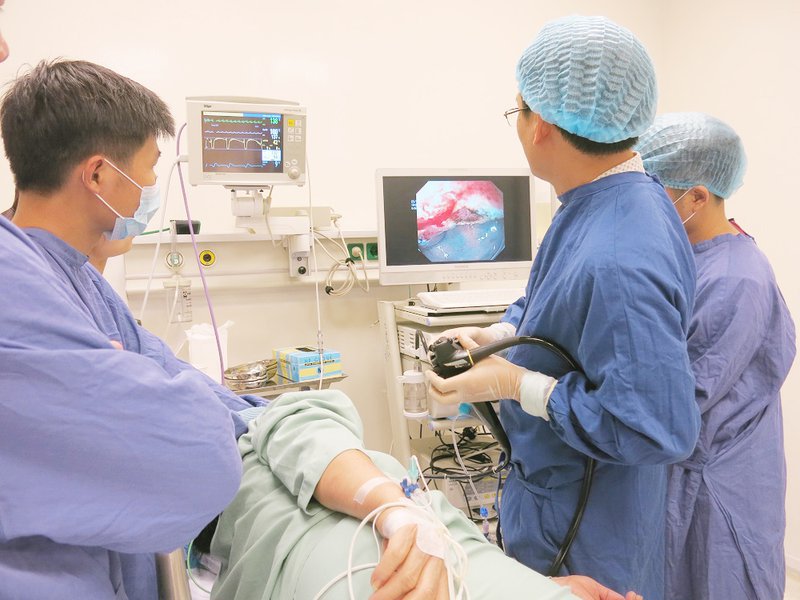What is endoscopic interventional gastrointestinal tract?
This is an automatically translated article.
The article is professionally consulted by Master, Doctor Nguyen Thai Binh - Gastroenterologist - Department of General Surgery - Vinmec Ha Long International General Hospital.
Thanks to the development of medicine, interventions on body parts are limited to the lowest level, especially the endoscopic array of gastrointestinal interventions. This technique is now being widely applied to treat many diseases instead of requiring surgery in the past.
1. What is gastrointestinal interventional endoscopy?
Interventional gastrointestinal endoscopy is a minimally invasive process that uses a thin, flexible, portable tube equipped with a camera, light source at the tip (other devices may be included depending on the type of scope). , and is capable of inserting the accompanying interventional devices through the lumen.
This tube will enter the body through natural openings (oral or anal) and in turn pass through the organs of the gastrointestinal tract. The captured camera image will be displayed on a separate large screen for the doctor to review, diagnose and decide on the intervention direction during the subsequent endoscopy.
Today, endoscopic gastrointestinal intervention is not only used to diagnose and treat stomach and colorectal diseases, but also can deeply interfere with other digestive organs such as small intestine, pouch bile, pancreas,...
2. Modern endoscopic techniques for gastrointestinal intervention
Some endoscopic interventional gastrointestinal techniques include:
Hemostasis of wounds with argon plasma (argon plasma coagulation hemostases) Direct cholangioscopy and pancreatic ductal endoscopy (cholangioscopy, pancreatoscopy) Cluster nerve disabling celiac nerve block for pancreatic pain Endoscopic gastrointestinal follow-up after bypass surgery Endoscopic mucosal resection (EMR) and ablation for removal and treatment early gastrointestinal tract tumors. Endoscopic retrograde cholangiopancreatography (ERCP) for benign and malignant conditions Endoscopic therapy for Barrett's esophagus, including radiofrequency ablation (RFA) and endoscopic resection Endoscopic ultrasound staging and fine-needle biopsy Endoscopic ultrasound diagnostics, cancer staging for cancers of the gastrointestinal tract, bile duct and pancreas Place and monitor percutaneous gastrostomy (percutaneous endoscopy gastrostromy - PEG) Aspiration of pancreatic pseudocyst Dilation of esophagus, small intestine, colon

Nội soi can thiệp đường tiêu hóa được sử dụng để chẩn đoán và điều trị các bệnh lý đường tiêu hóa
3. In what cases is gastrointestinal interventional endoscopy used?
Gastrointestinal interventional endoscopy is used for screening, diagnosis, treatment and monitoring in many different pathological cases such as:
Colorectal bleeding, polyps, cancer (can be resected). endoscopic polyp removal) Complications after weight loss surgery Esophageal diseases, including: Barrett's esophagus Dysplasia Esophageal cancer Gallbladder diseases, including: Gallstones Cholecystitis Chronic gallbladder cancer Gastro-intestinal diseases, including: Stomach-intestinal cancer Gastro-intestinal bleeding Gastro-intestinal pain due to malignancy Gastroesophageal reflux Diseases of the pancreas, Includes: Acute and chronic pancreatitis Pancreatitis Pancreatic cancer Pancreatic bifurcation Pancreatic pain due to malignancy Removing polyps prevents the risk of cancer progression

Bệnh viện Đa khoa Quốc tế Vinmec là địa chỉ uy tín nội soi can thiệp đường tiêu hóa
4. Advantages of endoscopic gastrointestinal intervention compared to traditional surgical methods
Compared with traditional surgical methods, endoscopic gastrointestinal intervention has outstanding advantages:
Less invasive The rate of complications is lower (however, the complication rate depends on the level of intervention in the gastrointestinal tract). During endoscopic procedures, the more interventional, the more likely to have complications, but in general, the complication rate of endoscopic interventional gastrointestinal tract is low, and is considered to be much safer than surgery. (traditional techniques) The time to perform the technique is generally shorter. The recovery time is fast. The hospital stay is shortened, and the cost is often lower. Besides the above advantages, thanks to the development of science and technology , endoscopic gastrointestinal interventions can now reach and affect areas that would be difficult to perform using traditional surgical methods, or if performed would present many risks to the patient. with patients, directly affecting treatment outcome and prognosis.
Currently, Vinmec International General Hospital is becoming a prestigious address for gastrointestinal endoscopy in early cancer diagnosis:
A team of highly qualified and experienced doctors. Comprehensive professional cooperation with domestic and international hospitals: Singapore, Japan, USA, .. Comprehensive treatment and care, multi-specialty coordination towards individualizing each patient. Having a full range of specialized facilities for diagnosis and staging before treatment: Endoscopy, CT scan, PET-CT scan, MRI, histopathological diagnosis, gene-cell testing, .. Master, Doctor Nguyen Thai Binh has more than 20 years of experience working in abdominal surgery. He is a former resident of Sainte Marguerite and Nord Hospitals (Marseille, France).
Please dial HOTLINE for more information or register for an appointment HERE. Download MyVinmec app to make appointments faster and to manage your bookings easily.
Article referenced source: NCBI





